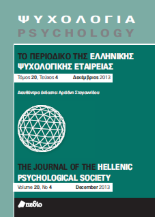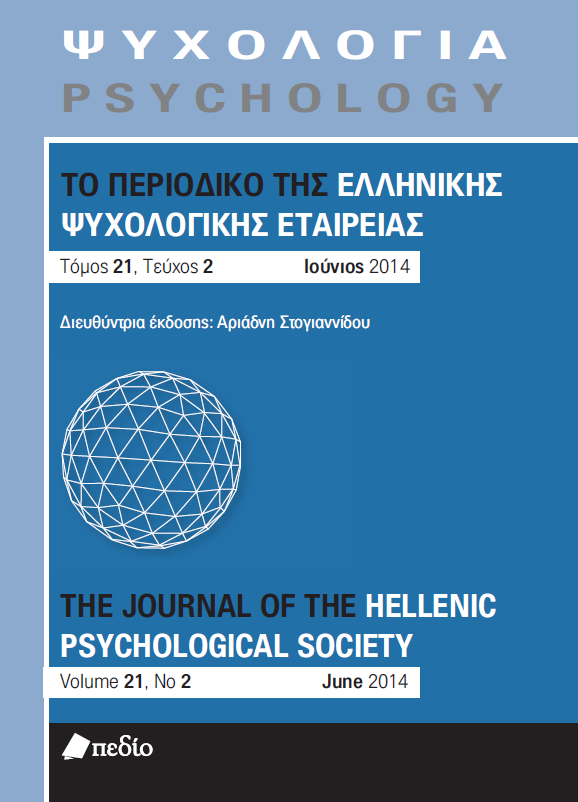Γλωσσική Προσαρμογή και Ψυχομετρικά Χαρακτηριστικά της Κλίμακας University Student Depression Inventory (USDI)
Περίληψη
Στόχος της παρούσας μελέτης είναι η προσαρμογή και η αξιολόγηση των ψυχομε- τρικών χαρακτηριστικών της ελληνικής εκδοχής του University Student Depression Inventory (USDI). Μετά τη γλωσσική και εννοιολογική προσαρμογή του, η ελληνική εκδοχή του USDI χορηγήθηκε σε 248 φοιτητές του Πανεπιστημίου Κρήτης. Για την αξιολόγηση της παραγοντικής δομής του εργαλείου χρησιμοποιήθηκε η επιβεβαιωτική ανάλυση παραγόντων, όπου αξιολογήθηκαν και συγκρίθηκαν τέσσερα διαφορετικά μοντέλα: το μοντέλο του ενός παράγοντα, το μοντέλο των τριών συσχετιζόμενων παραγόντων, το ιεραρχικό μοντέλο και το αμφιπαραγοντικό (bifactor) μοντέλο. Τα αποτελέσμα- τα έδειξαν ότι το αμφιπαραγοντικό μοντέλο είχε την καλύτερη προσαρμογή στον ελληνικό πληθυσμό, έπειτα από την αφαίρεση ενός στοιχείου (στοιχείο επτά). Για την αξιολόγηση της εγκυρότητας της κλίμακας χορηγήθηκαν τέσσερα επιπλέον ψυχομετρικά εργαλεία, τα οποία μετρούν συγγενείς εννοιολογικές κατασκευές (π.χ., προσωπικότητα, ψυχολογική ευζωία, κατάθλιψη και άγχος), στη προσπάθειά μας να τεκμηριώσουμε τη συγχρονική, τη συγκλίνουσα και την αποκλίνουσα εγκυρότητα της ελληνικής εκδοχής. Τέλος, μελετήσαμε την εσωτερική συνοχή των στοιχείων της κλίμακας με τη χρήση του δείκτη ωμέγα (omega). Τα αποτελέσματα έδειξαν ότι η ελληνική εκδοχή του USDI αποτελεί ένα έγκυρο και αξιόπιστο εργαλείο για τη μέτρηση της κατάθλιψης στον ελληνικό φοιτητικό πληθυσμό.
Λεπτομέρειες άρθρου
- Πώς να δημιουργήσετε Αναφορές
-
Κουτσουμπής Α., Καριπίδου Ε., Μπουρελάκη Σ., Τσαρτσίδου Α., & Τσαούσης Ι. (2018). Γλωσσική Προσαρμογή και Ψυχομετρικά Χαρακτηριστικά της Κλίμακας University Student Depression Inventory (USDI). Ψυχολογία: το περιοδικό της Ελληνικής Ψυχολογικής Εταιρείας, 23(2), 163–181. https://doi.org/10.12681/psy_hps.23007
- Τεύχος
- Τόμ. 23 Αρ. 2 (2018)
- Ενότητα
- ΕΜΠΕΙΡΙΚΕΣ ΕΡΓΑΣΙΕΣ

Αυτή η εργασία είναι αδειοδοτημένη υπό το Creative Commons Attribution-ShareAlike 4.0 International License.
Το περιοδικό ΨΥΧΟΛΟΓΙΑ έχει υιοθετήσει μία πολιτική Platinum open-access. Τα έξοδα υποβολής, επεξεργασίας ή δημοσίευσης των εργασιών καλύπτονται από την Ελληνική Ψυχολογική Εταιρεία. Τα πνευματικά δικαιώματα των δημοσιευμένων εργασιών προστατεύονται από την άδεια 'Creative Commons Attribution-ShareAlike 4.0 International'. Οι Συγγραφείς διατηρούν τα Πνευματικά Δικαιώματα και χορηγούν στο περιοδικό το δικαίωμα της πρώτης δημοσίευσης. Η άδεια αυτή επιτρέπει σε τρίτους, να χρησιμοποιούν την εργασία σε οποιαδήποτε μορφή, με την προϋπόθεση της διατήρησης των διατυπώσεων που προβλέπονται στην άδεια σχετικά με την αναφορά στον αρχικό δημιουργό και την αρχική δημοσίευση στο περιοδικό ΨΥΧΟΛΟΓΙΑ. Επιπλέον, κάθε διανομή της εργασίας οφείλει να γίνεται με τους ίδιους όρους διανομής, δηλαδή με την ίδια άδεια Creative Commons.








